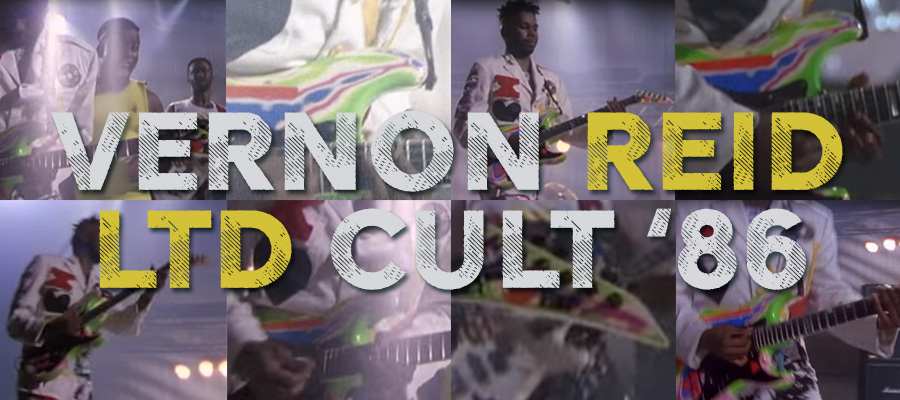Vernon Reid on the LTD Cult '86
Vernon Reid on the LTD Cult '86


In 1986, ESP Guitars was a new instrument company in the United States, and we opened our first US offices on 19th Street in New York City. At the same time, guitarist Vernon Reid was making a name for himself as a virtuoso player whose styles spanned several genres. At the time, Vernon had just put together the early incarnation of a band called Living Colour, and needed a guitar that offered the performance level necessary for his intense leads and funky rhythms. Note that while Vernon is not a current ESP artist, the new LTD Cult ’86 is meant to commemorate an era in both Vernon’s and ESP’s history that marked a launching point for great things to come.
Vernon, you were one of the very early adopters of ESP in the United States. Tell us the story of how you first became aware of ESP, and how you originally connected with us.
As I remember it, I was starting to be known in New York, playing in Ronald Shannon Jackson’s band The Decoding Society. I started to get some local notoriety for that. I then appeared with Ronny Drayton on the cover of Musician Magazine.
I was also a denizen of 48th Street too. I was always hanging around to see the latest and greatest in all the shops that were there… Sam Ash, Manny’s, Louie’s Music. They were all right there. I think that’s how the word got around about me.
What memories do you have of ESP in the early days in New York?
I remember meeting Steve Kaufman. He was the head of the New York office for ESP on 19th Street. That’s where it really started. We just hit it off and I met the whole crew. All great guys, like Ritchie Fliegler. The person I have the closest memory of was Paul Skelton, who was the in-house luthier, builder, tweaker, and inspector. He was a brilliant guy from Austin, Texas. He had shaggy hair and reminded me of Neil Young. He was a hip dude. A fan of Coltrane, but also a blues guy. He was a mensch, in New York parlance.
It really was an interesting collection of dudes, like madmen running their own little asylum. I had a huge amount of affection for that group of people. They were funny guys, smart guys. They basically either customized or modified all of my instruments.
Paul Skelton had this amazing quality control technique. I’d be there when shipments of guitars would come through. Paul did this “one-strum quality control” thing. He’d open the case, pick up the guitar, strum a single chord and say, “Nope! Send it back.” Another strum. BRANG! “Piece of shit.” BRANG! “Needs a fret job.” BRANG! “This one’s pretty good.”
Tell us the story of the first guitar that ESP created for you. That’s the guitar we’ve used as the inspiration to create the new LTD Cult ’86.
Steve said, “Man, we want to build you a guitar.” I looked around the showroom and there was a guitar that Bruce Kulick was having made. I saw this kind of crazy finish on the guitar. It kind of looked like radio waves. It reminded me of the art from Jack Kirby of Marvel Comics. It was like the Silver Surfer. It had the power of cosmic lightning, electric craziness. That’s what the Kulick finish reminded me of. Something from one of my favorite comic books. I said, “I want that finish.”
You must have been a pretty early adopter of active pickups.
At the time, EMG pickups were the new thing on the street. Everyone was raving about active pickups.
How about the feel of the neck?
I wanted a v-shaped neck profile. I had played a ’63 Fender with a v-shape neck, and it felt really good. I requested a v-shape neck profile.
You were doing very creative things with the Floyd Rose tremolo at the time.
There was the Floyd Rose, which was coming into vogue, popularized by Eddie Van Halen. It actually wasn’t my first choice. I was a big fan of Adrian Belew from his work with King Crimson and Talking Heads, and he had a Kahler. But Paul talked me out of it. Paul, or maybe Richie, talked me out of it. They feel good, but are really hard to keep in tune. I begrudgingly went with the Floyd on their recommendation.
How did the whole process go in creating the guitar?
I was talking to Steve and Paul. They jotted down different things. I think I even drew a little stick figure that they also included… something I drew on a 3”x5” card. They even included this little stick figure.
They took all that in, and then I was kind of waiting, waiting, waiting. About six weeks later, it came through, man! Paul was like, “It’s really good.” When Paul said that, that’s when I knew. They couldn’t wait for my reaction. I opened the case, and it was like, “Holy shit!”
Was Living Colour already rolling at this point?
I started putting Living Colour together in 1984. Around ’85-ish, we started to gain a local following. It really picked up when we moved from a trio to a quartet. I had met Corey Glover through my sister, and we started to hit clubs around town, playing CBGB’s.
So, it took off around that time. When I got the ESP guitar, it really shifted things for me. Before then, I had a “frankenstrat” that I played that on the first Public Enemy record. There was a painting on it by (renowned American visual artist) Keith Haring.
What?!?!
Yeah, man. Keith Haring. I was a huge fan of the glowing baby. I used to play this guitar, and I’m starting to rub off part of the thing. Keith asked me if I wanted him to sign it. Hell yes! But I’d been playing this guitar, and it was falling apart.
I thought, “I can’t keep playing this guitar.” I had no idea what it was worth. So I took it to ESP, and Paul Skelton worked on it for me. What Paul did, he kind of cut out the piece of the pickguard that had Keith Haring’s signature, and glued it to the new guitar.

The LTD Cult '86 commemorates Vernon Reid's early relationship with ESP at the time when his band Living Colour did their iconic debut album.
That guitar, famously, ended up being the main one you used on the creation of the debut Living Colour album Vivid. I remember hearing “Cult of Personality” for the first time, and it was shocking. It didn’t sound like anything else that was around at that time. How did your ESP come into the creative process for that album?
The ESP had replaced my “frankenstrat”. One of the first photos of me in Rolling Stone was with a picture of this instrument. The ESP coming into my life at that point was a shift. It was specifically for the band Living Colour. It was a colorful band name; I thought I should have a colorful guitar, right?
The other thing about it is that “Cult of Personality was written on that guitar. The new model being called Cult ’86 is for a reason. That first riff, the whole thing. “Cult” was written on that instrument.
 Tell us a little bit about the creation of that song.
Tell us a little bit about the creation of that song.
It was a confluence of things. We used to rehearse in Bushwick, long before it was called East Williamsburg. We’d get in Wayne’s van, take our stuff, and go across the Williamsburg Bridge, take a right and a left and another right, and head straight to CBGB’s.
“Cult” was written in one rehearsal. It was unusual, because the entire rehearsal was dedicated to writing that one thing. We started without any ideas, and ended with “Cult”. Corey started singing this thing, and I yelled to Will to play a beat! The song wrote itself. A few days later, we went to CBGB’s and played it for the first time.
You’re not the first person to find immediate inspiration from a new guitar.
As soon as I got it, I was playing it all the time. It was the best new thing in the world for me. It was a fun guitar to play. It sounded great through the pedals. In fact, when I later moved to another guitar company, that guitar was the model. I took it in and said, “You have to build something that matches this.” Jol Dantzig, actually, paid this guitar the ultimate compliment. He asked, “Would you mind if we get the guitar for a couple of weeks to try and match it?” Afterwards, he said, “This is a great guitar!” From someone who was at a different company, a competing company, I thought that was the greatest tribute.
On a general basis, what matters to you most when considering a new guitar?
It’s gotta sound great acoustically, without applying electricity. It has to sound really nice acoustically. It should ring and resonate. It shouldn’t feel like a dead thing that needs a bunch of outside stuff to sound good.
Second thing, it has to feel great in the hands. Guitar playing is a feedback loop. If you receive pleasure from the feel of playing, you are going to play better.
You always hear about guys talking about other guitarists, and they say things like, “He played a piece of shit and he still sounds great.” I don’t buy that. If that same guy is given a guitar that actually sounds great and plays well, he’s going to call down Moses. It’s just a fact. If it sounds and feels great, it inspires you. It removes everything out of the way, except for yourself.
The third thing… after the sound and the feel, the look of it is highly subjective. I have a whole thing about headstocks. Nothing messes up the look of a guitar more than a badly designed headstock. It’s like the grill of a car. If the grill of a car is working, the body can be great, but if not, you see it and it’s like, “Oh God, that car again.”
Finally, there are the things that you expect from a high quality design, like being well shielded. If the guitar is otherwise good but it’s a humming mess all the time, you really don’t want that.
Your musical background has a ton of variety, and ranges from jazz to metal to funk to punk to just about everything. How important is it for young musicians to expose themselves to multiple genres and styles of music?
Well, I would say it’s a function of your own spirit and interests. If you’re metal through and through and that’s what you do, there’s nothing wrong with that. Younger players tend to be fixated on one style, and that’s fine. If you think about it, a lot of metal is derived from classical, but there would be no metal without blues. You look at guys like Ritchie Blackmore, or Gary Moore, who both made use of interesting classical chops, but were very influenced by blues. Yngwie says that his favorite guitarist is Jimi, though they played very differently, of course.
The ability to listen to other styles… it’s a human thing. You have a familiarity to the things you connect to, which in turn makes you afraid of connecting to other things. Humans are afraid of change, but then we develop. Alex Skolnick is a musician who I respect a great deal. He was already recognized as a preeminent metal guitarist, but then decided to investigate jazz and put a huge amount of effort into studying a whole new style. I have huge respect for him for doing that.
Look at Disturbed’s version of “The Sound of Silence”. It’s 100% legit to hear that song in that style. You have to be open to not dismiss a song and call it hippie shit that your parents were into. Let the song itself work its magic on you.
I follow your Twitter feed and find that I always enjoy what you have to say about everything from music to culture to politics. What are the upsides and downsides of a musician who is engaged on social media?
I will say this: I love Twitter. It allows me to talk on all different sorts of things. Controversies of the latest comic book movies, or Black Lives Matter, all kinds of various things. Some of my followers do not share my political views, but I don’t get into the name calling. It’s not helpful. Just because someone has a different point of view, I will not pop off and label them.
I will engage though. That’s the important thing. I try to engage fairly honestly, and with respect. What’s happened in the anonymous nature of social media is that some people will inevitably use it to play games, to troll, all that stuff. Hey, if being on Twitter releases your inner troll, I guess you have things to talk to yourself about at 2am when you don the cape of a super-villain.
Tell us about what you’re up to right now. We’ve been waiting for new Living Colour material for a long time. When does the new album hit?
2017. It’s a funny thing. What happened is that the new record took three years, and four managers, to make. We’ve been through a lot.
This record is oddly appropriate for the time we’re in. The record we made is not a blues record per se, but the element of blues is part of it. The producer we worked with, Andre Betts, has a background in hip hop, but it’s not a rap record.
There are different element that come together on this record. I really like it. We covered Biggie Smalls’ “Who Shot Ya?”. When we did the EP, it was interesting that all of a sudden, there happened to be a focus on talking about gun violence. Corey is a big fan of Biggie, and he was always doing “Who Shot Ya?” in sound check. It keeps up conversations about Christopher Wallace, and what really happened to him.
We did a track with help from some guys from New Orleans. Roosevelt Collier came in and did pedal lap steel. We had Big Sam on the trombone. Marc Cary on the organ. It’s the first time we did songs with the whole horn thing on it, and it brought a whole new element. The final song on the album is called “Two Sides”, and it’s pretty much our nod to Pink Floyd with a cameo from George Clinton on it.
We can’t wait to check it out. Any final thoughts on what makes the Cult ’86 a special guitar?
I always loved guitars that had an iconic attachment to their players. An example is Eric Clapton’s “The Fool” guitar, or Jimi’s white Strat. The instrument becomes a signifier, a symbol of the player. With the guitar that was the inspiration for the Cult ’86, it subsequently inspired me to write that riff on that guitar. I can tell you that “Cult of Personality” would have been different on any other guitar. It’s a really cool feeling, and it’s a marker of how significant one instrument can be.
Interesting. So ESP we're actually persuading people not to use Kahler even when they wanted it? Wow.
Now I know why not many models feature a kahler which I much prefer over a floyd rose even though I also have guitars with FR - I always much prefer playing a guitar with a kahler and would disagree that they are hard to keep in tune. Exactly the opposite. I've even been able to continue to finish the song in tune after busting a string on a guitar with a kayler - but never been able to with a floyd rose. The only thing a floyd rose is useful for that a kahler can't is steve vai cat purr / miow style which a kahler is too stable to continue the vibration.
i would have bought more ESP models if there had also been a kahler option.
Well, there are the Jeff Hanneman models.
But let's be honest. there is no "audience" anymore for Kahler.
The last literally died with Jeff, sadly.
Supply and demand thing. People are mostly asking for fixed bridges at the moment,
Evertunes and Hipshots mainly. Maybe that trend will turn around in a few years, but
at the moment der is no demand for it.






